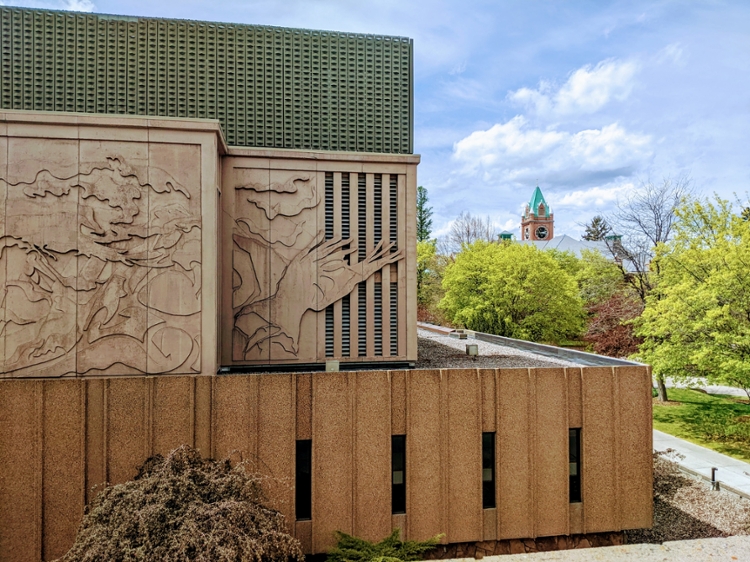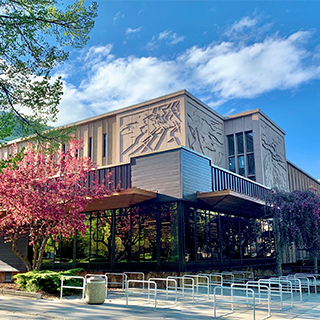History of the Mansfield Library
Mike Mansfield: Montana Statesman
In the late 1920's, Michael Joseph Mansfield met Maureen Hayes, a Butte high school teacher, who was impressed with his unusual talents and urged him to complete his education. He completed his high school work and was admitted to the School of Mines at Butte by examination, then transferred to the University of Montana in Missoula. 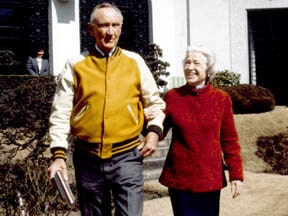 With her financial and moral support, Mike received his bachelor's degree in 1933 and completed his master's degree in history in 1934, writing on Korean-American diplomatic relations. Maureen also received a master's degree in English from UM in 1934. Mike Mansfield also taught at the University of Montana from 1934 to 1942, served ten years in the U.S. House of Representatives, and 24 years in the U.S. Senate. As majority leader from 1961 to 1977, Mansfield guided the Senate through one of the nation's most troubled eras, marked by cold war, presidential assassination, racial strife, social turmoil, and the Vietnam War. In addition to holding the distinction of being the Senate's longest serving majority leader, Mansfield championed a policy to establish normal diplomatic relations with China. In 1976, President Jimmy Carter appointed him ambassador to Japan where he served until his retirement in 1988. Maureen and Mike lived in Washington, D.C., until her passing in 2000 and his in 2001.
With her financial and moral support, Mike received his bachelor's degree in 1933 and completed his master's degree in history in 1934, writing on Korean-American diplomatic relations. Maureen also received a master's degree in English from UM in 1934. Mike Mansfield also taught at the University of Montana from 1934 to 1942, served ten years in the U.S. House of Representatives, and 24 years in the U.S. Senate. As majority leader from 1961 to 1977, Mansfield guided the Senate through one of the nation's most troubled eras, marked by cold war, presidential assassination, racial strife, social turmoil, and the Vietnam War. In addition to holding the distinction of being the Senate's longest serving majority leader, Mansfield championed a policy to establish normal diplomatic relations with China. In 1976, President Jimmy Carter appointed him ambassador to Japan where he served until his retirement in 1988. Maureen and Mike lived in Washington, D.C., until her passing in 2000 and his in 2001.
Beginnings
The University's first library was established in 1895 in the old Willard School on Sixth Street. Mary Craig, daughter of the University's first president, was head librarian and oversaw circulation of 187 volumes. By the end of the year, library holdings had increased to 1,369 volumes, 19 periodicals, and 20 newspapers. Four years later, the library moved to University Hall, one of the two new buildings which served as base for the young campus.
In 1908, the library found new quarters on the ground floor of the three-story brick building now called Jeannette Rankin Hall. Campus faculty pressed for additional library holdings and library purchases were increased accordingly. At the same time, the library was designated a depository for government documents.
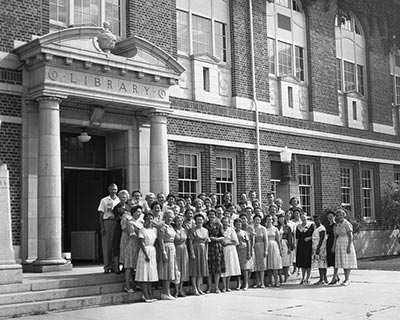
Growth
By early 1920, it became apparent the library needed quarters of its own. Construction of a new library, now called the Social Science Building, was completed in 1921 and library resources were relocated. Some thirty years later, growing collections required the addition of a structure on the library's north side, temporarily relieving the immediate space problem until funding for a larger building could be obtained. During this time, the library received outside support from the Friends of the Library. Formed in 1960 by students, the Friends proved a valuable advocate. Support for a new building continued to grow and construction began in 1970 across the mall from the University Center.
By 1974, three floors of the five-story building were occupied. Construction to finish the fourth and fifth floors was completed in November 1978, funded by the U.S. Department of Commerce. The following fall, in conjunction with the University's 1979 Homecoming activities, the University library was named after Ambassador Mike Mansfield and his wife Maureen.
In 1992, the Mansfield Library implemented an online catalog offering users electronic access to information resources. With the reorganization of the Montana University System in 1994, all of the Mansfield Library system holdings have been incorporated into the online catalog, allowing user access of our combined holdings of over 1.5 million volumes on the campuses at Butte, Dillon, Helena, and Missoula.
In May 2000, the Maureen and Mike Mansfield Library marked an historic milestone when it added its one-millionth volume and its periodical and newspapers holdings now number in the thousands.
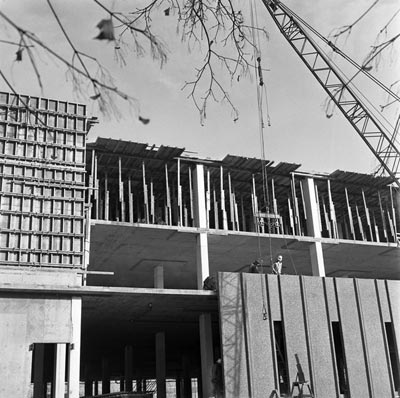
Transformation
The Mansfield Library faces new challenges as it seeks to incorporate rapidly changing technology into research and teaching processes, as well as operations and activities. Its history of growth and change provides a solid foundation for meeting these challenges. The Maureen and Mike Mansfield Library is committed to providing wide access to material it has acquired in the past and using rapidly changing technology to deliver the information needs of the future.
